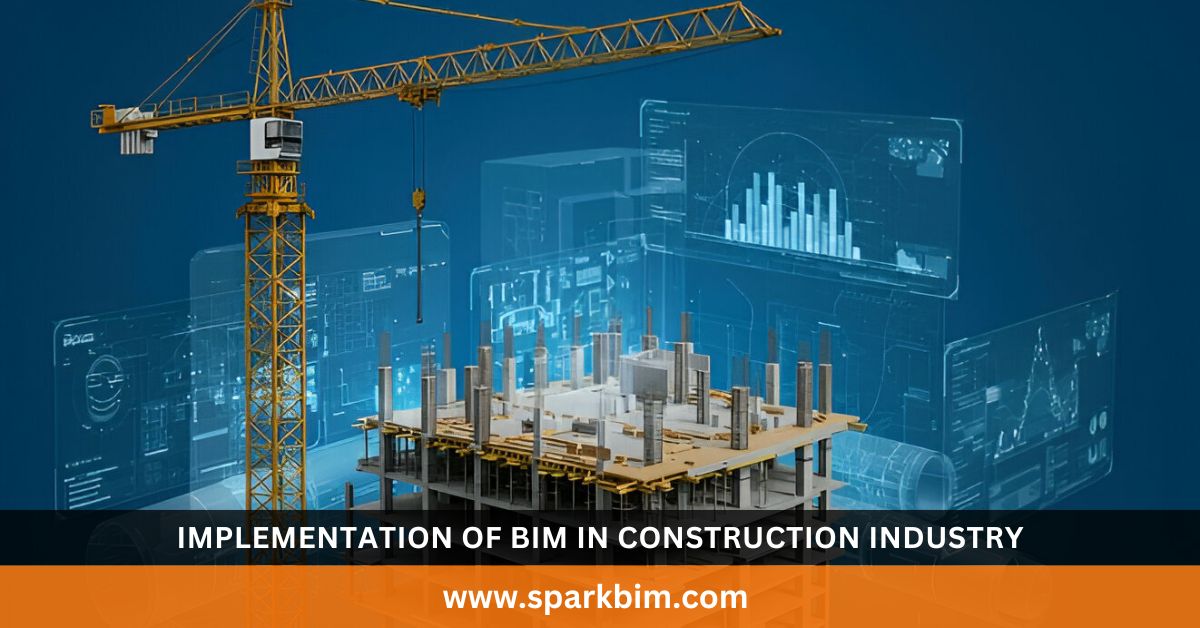Table of Contents
ToggleBuilding Information Modeling (BIM) is a digital tool that has completely transformed the construction industry. The implementation of BIM in construction industry has brought about improvements in the way we design, plan, and execute construction projects.
The technology enables better communication, increased efficiency, and a more streamlined process throughout the building’s lifecycle.
Whether you are a contractor, architect, project manager, or any other stakeholder in the construction industry, understanding how BIM works and how to implement it effectively can set your projects up for success.
In this blog post, we will explore the implementation of BIM in construction industry, including the essential steps, advantages, and challenges associated with it. We will also dive into creating a BIM implementation plan and how it can help your company achieve smoother, more cost-effective projects.
Why is BIM Important in the Construction Industry
Incorporating BIM into your projects isn’t just a trend; it’s a necessity. The implementation of BIM in construction industry brings numerous advantages that can improve both the quality and efficiency of construction projects.
How BIM Adoption Can Improve Your Project Outcomes
1. Improved Communication and Collaboration
BIM allows all stakeholders to access and modify the same digital model, creating a central source of truth. As everyone works on the same platform, there’s less chance for miscommunication, reducing the risk of errors and costly project delays.
2. Cost Efficiency
One of the primary reasons to adopt BIM is its ability to save costs. By identifying potential design flaws early on, BIM helps prevent rework, material wastage, and delays.
Additionally, BIM models can help contractors estimate costs more accurately, ensuring that budgets are adhered to throughout the project.
3. Better Decision-Making
BIM integrates real-time data and 3D visualisations, which enables stakeholders to make better, informed decisions. This data helps identify potential challenges early and allows teams to develop solutions before they impact the project timeline.
4. Improves Project Delivery
BIM accelerates the entire project delivery process. From design to construction to operation, the ability to plan, execute, and monitor each phase more effectively helps deliver projects on time and within budget.
Also Read, As Built Modeling for Construction Project Management
5. Sustainability and Energy Efficiency
BIM can also be used to optimize building designs for energy efficiency. By simulating building performance under various environmental conditions, BIM can help identify ways to reduce energy consumption and minimize the building’s ecological impact.
The implementation of BIM in construction industry enhances both the design and execution phases of a project. With these improvements, teams can work more collaboratively, finish projects on time, and ensure that costs remain under control.
The BIM Implementation Process
Successfully implementing BIM in the construction industry requires a structured, organized approach. It’s not enough to simply purchase BIM software and start using it.
Instead, a strategic process must be followed to ensure that BIM is integrated effectively into your company’s workflows.
Steps in the BIM Implementation Process
1. Define Objectives and Set Goals
Before diving into the technical aspects of BIM adoption, it’s important to define what you want to achieve. For example, are you aiming to reduce construction costs? Improve coordination between teams? Or enhance the speed of project delivery? Setting clear goals will guide your BIM implementation process and help you measure success.
Additionally, consider the long-term benefits of BIM, including post-construction management, sustainability, and the ability to easily modify the design in the future. These goals should align with your company’s broader objectives and vision for growth.
2. Assess Your Current Capabilities
Not every company is starting from scratch when it comes to technology. If your team is already using CAD software or project management tools, assess how these systems can be integrated with BIM.
The more you understand your starting point, the easier it will be to develop an actionable BIM implementation plan for your company.
Evaluate the hardware capabilities, software tools, and the existing skill levels of your team. You may need to upgrade systems or invest in new technology. This will ensure that you have the infrastructure in place to support BIM adoption.
3. Develop a BIM Execution Plan (BEP)
A BIM Execution Plan (BEP) is a comprehensive document that outlines how BIM will be implemented for a specific project. The BEP should include:
- BIM Goals and Objectives: What do you intend to achieve with BIM on this project?
- Software and Tools: Which software tools will be used (Revit, AutoCAD, Navisworks, etc.)?
- Roles and Responsibilities: Clearly define who will be responsible for what in the BIM workflow.
- Data Management and Exchange: How information will be shared and stored.
- Collaboration Guidelines: Rules for collaboration between various teams (architects, engineers, contractors).
Having a detailed BEP ensures that all team members understand their roles and responsibilities, which is crucial for the successful implementation of BIM in construction industry.
4. Train Your Team
Training your team is perhaps one of the most important steps in the BIM implementation process. Without the necessary skills and knowledge, even the best BIM tools are useless.
Companies often invest in BIM implementation services, which provide training sessions and workshops to bring employees up to speed. BIM software is complex and requires specialized training. Whether your team uses tools like Revit, Navisworks, or others, it’s important to provide ongoing learning opportunities.
It ensures that team members are well-equipped to handle any challenges that arise during the implementation process.
5. Implement Software and Tools
At this point, it’s time to implement the software and technology that your team will be using. You’ll need to install the necessary software, configure it to suit your project needs, and ensure that data is being shared effectively between platforms.
If you’re planning to use Revit, make sure you have a Revit implementation plan in place. This plan will cover software setup, integration with other systems, and customization based on your project’s requirements.
Also Read, Plumbing BIM Modeling in Construction
6. Monitor and Review
Once the software is in place and the project is underway, it’s crucial to monitor the BIM implementation continuously.
Track how well the tools are being utilised and make adjustments as necessary. Regular reviews allow you to identify areas where the process could be more efficient and provide additional training or support where needed.
Benefits of BIM Implementation
The implementation of BIM in construction industry provides a host of advantages that positively impact the project at every stage.
1. Reduced Errors and Conflicts
BIM helps in the early detection of design errors and conflicts, which can be identified in the 3D model before construction begins. This eliminates costly last-minute changes on-site and ensures that the project remains on schedule.
2. Better Collaboration and Communication
BIM provides a centralised platform where all project members can collaborate. This eliminates the confusion of multiple versions of documents and ensures that everyone is working with the same up-to-date information.
3. Improved Project Coordination
BIM integrates information from various disciplines, including architecture, structure, and MEP (mechanical, electrical, plumbing). This coordinated approach ensures that all aspects of the project are aligned, leading to fewer miscommunications and misunderstandings.
4. Improves Visualization
With BIM, you can create highly detailed 3D models, giving you a clear visualisation of the design. This improves client engagement and makes it easier for all stakeholders to understand the project.
5. Faster Project Delivery
By streamlining the design, planning, and construction phases, BIM enables faster delivery of projects. With better planning, fewer delays, and more efficient workflows, the project can be completed on time.
Challenges in Implementing BIM
While the implementation of BIM in construction industry offers numerous benefits, it’s not without its challenges. Some of the common hurdles include:
- Cost of Implementing BIM: The cost of implementing BIM can be high, especially for smaller companies. This includes expenses for software, hardware, training, and possibly even hiring specialised staff. While the upfront costs can be steep, the long-term savings and benefits make it worthwhile.
- Resistance to Change: Many employees may be used to traditional construction methods and tools. Overcoming this resistance requires a culture shift, proper training, and clear communication about the benefits of BIM.
- Data Integration Issues: Integrating BIM with existing project management or construction systems can sometimes be a challenge, especially if those systems are outdated or incompatible with BIM software.
- Skill Shortages: BIM requires specialised skills that are in demand. It may be necessary to bring in external expertise or invest heavily in training to fill the knowledge gap within your team.
Conclusion
The implementation of BIM in construction industry is not a fleeting trend but a game-changer that is here to stay.
As the industry becomes more tech-savvy, BIM adoption will continue to grow, making construction projects more efficient, cost-effective, and sustainable.
By carefully following the BIM implementation plan outlined above, addressing the challenges, and investing in the right tools and training, your company can benefit from the many advantages BIM has to offer. As the future of construction continues to evolve, BIM will play a key role in shaping the way we build and manage our cities and infrastructure.


